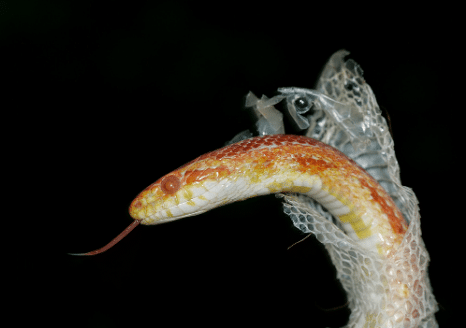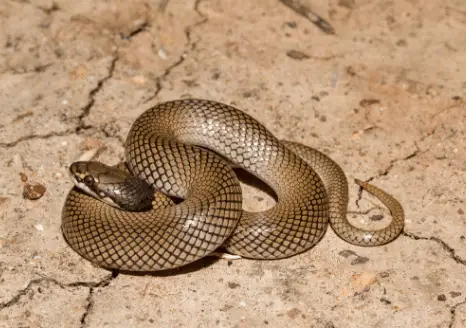In short, yes. All snakes have spines. Reptiles are vertebrates, which means they have a solid skeleton of bone and cartilage. The more vertebrae a snake has, the longer its body will be. The formation of the spine and its component part affects all aspects of a snake’s life.
Snake Anatomy
Snake skeletons are comprised of three main components: the skull, vertebrae and ribs. A subset of snakes, including Boas and Pythons, also have vestiges of hind limbs and hip bones, although they have no physical uses.
So do snakes have spines? yes, the structure of a snake’s spinal column is what affords it such astonishing flexibility. Each vertebrae is connected to the next by intervertebral discs formed from cartilage and a network of muscles. This allows a greater range of motion than other vertebrate species.
Humans for example, have 33 vertebrate bones in their spinal column. Snakes, depending on the species, can have anywhere between 100 and 605 bones in their spine! Snakes have two types of vertebrae.
The Precaudal vertebrae form the main body from the base of the skull down to the base of the tail. Snakes can have 100 to 400 Precaudal bones dependent on their species. Each Precaudal vertebrae has a pair of ribs attached to it. These ribs have ball and socket joints allowing them both lateral and vertical range of motion. These flexible ribs aid the process of digestion as well as increasing mobility.
The Caudal vertebrae form the tail section. Generally, these vertebrae do not have any attached rib bones. The tail section of a snake has between 10 and 205 vertebrae.
Do Snakes Have Stomachs?

Snakes are able to eat prey almost the same size as themselves. To do this, they require a fully functioning and complex digestive system, which includes the mouth, oesophagus, stomach, intestines and anus. Prey animals are usually a similar size or larger than a snake’s head. The upper and lower jaws of a snake’s skull are able to open up to 150°. In addition, the lower jaw is not fused. The two pieces of bone are connected by ligaments which allow them to open their mouths outwards as well as in an up and down motion. This allows large animals to pass easily.
The ribs are also an important factor in safe and effective digestion. The ball and socket joints of the ribs allow movement laterally and vertically. The snake can utilize this by performing sideways and up/down motions of its body to assist the movement of its prey through the digestive tract.
To avoid internal injury from horns, claws and limbs, prey animals are normally swallowed headfirst and whole. The glands in the mouth secrete saliva containing digestive enzymes. This saliva coats the prey to make it easier to swallow and the enzymes begin the process of digestion.
Due to their slim and elongated physiology, a snake’s organs are located along the length of its body. The lungs are located on either side of the body with the oesophagus between them, connecting the mouth to the stomach. The stomach itself is J-shaped and made of elastic tissue to allow for stretching. This is where the majority of digestion takes place. Gastric juices and enzymes are released from the lining of the stomach to break down proteins.
Like all reptiles, snakes are ectothermic, which means they use the temperature of their surroundings to regulate their body functions. Digestion is maximized in temperatures above 20°C (68°F).
The action of swallowing puts the snake at risk of attack from predators or other snakes. Swallowing large prey like an antelope or pig can take several hours. If a snake senses a threat, it will regurgitate its prey. When temperatures are too low, digestion is inhibited, which often results in regurgitation. The act of regurgitation can cause serious internal injuries, particularly from horned or spined prey.
Shedding

Just like their stomachs, a snake’s skin is elastic. This enables the skin to stretch and accommodate large prey animals. As a snake grows, it periodically needs to shed its skin. This occurs 4-8 times per year, depending on the snake’s growth rate, age, external temperature and feeding frequency.
Younger snakes will shed more frequently since they experience a greater growth period in the first year or two of life. People who keep snakes as pets are advised not to handle their snakes during a shed. This is because their eyesight is limited due to a build-up of fluid and this can make them aggressive. In the period before shedding starts, their scales will become dull and they will be less active than normal.
The shedding process is similar to how you would peel a banana, so a snakeskin that has been shed is actually inside out. It takes 1-2 weeks for shedding to complete and their eyes will return to normal color and function within 7-10 days.
Conclusion
So do snakes have spines? yes, and they are vital in the process of digestion, movement and shedding, with a structure unique to their family. The complex network of vertebrae, ribs, muscles and ligaments allow them to shed their skin, digest mammoth meals and hide themselves in the tiniest of spaces. Snakes are the contortionists of the animal kingdom!





